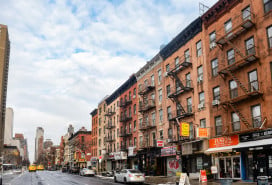Cheap trick: How much you can save when buying an older property in NYC
- Properties built in the past decade are nearly 60 percent pricier than older ones, per a PropertyShark report
- The average NYC building was constructed in 1952, and some neighborhoods have little new housing stock
- You can search sales prices of old and newer apartments in your neighborhood at the end of this story

In Chelsea, the median sales price for a newer apartment hovered around $4 million, compared to $1 million for an older unit, according to PropertyShark.
iStock
Buying an apartment in New York City can mean breaking the bank, but buying a shiny, new place just might encourage armed robbery.
Apartments and single and two-family homes built in the past decade cost around 58 percent more than older properties with a median price of $1.15 million, according to a new report from PropertyShark.
“Generally, new construction delivered higher prices, but not uniformly,” wrote Eliza Theiss in the report. “In Manhattan’s luxury corridors, new towers command staggering multiples, whereas in co-op heavy or affordability-driven areas, the same new label carries little or no premium.”
It’s no secret that newer, modern (but hopefully not too modern) apartments are pricier. While the vast majority of NYC’s housing is much older—the average building was constructed in 1952—an influx of luxury development has resulted in plenty of high-priced apartments out of reach for many would-be-buyers.
But just how much more expensive are the city’s newer condos, co-ops, and houses? Read on to find out.
Renovated condos and co-ops don’t come cheap
Citywide, condos built in the past 10 years sold for a median price of $1.14 million, 15 percent higher than the $995,000 median price for older units, per PropertyShark.
That’s in part due to a development boom in Brooklyn and Queens, where nearly half of condo sales from July 2024 to June 2025 were for units built in the past decade.
Co-op sales represented 43 percent of deals that closed during that year-long period, and almost all of those transactions were for older units. (FYI: New co-ops are exceedingly rare in NYC.)
But deals for renovated co-ops landed drastically higher prices. In Manhattan, newly renovated co-ops sold for a median price of $1.78 million, while older units traded for just $800,000. (Upgraded condos also saw an elevated median sales price of $1.65 million.)
A tale as old as NYC’s housing stock
The city’s notoriously older housing stock dominates the sales market. In 26 neighborhoods—including Rego Park and Forest Hills in Queens—more than 90 percent of the condos, co-ops, and detached houses sold were built before 2015, according to PropertyShark.
But in neighborhoods seeing an increase in new development, the price divide between newer and older housing was particularly visible. In Long Island City, for example, newer condos, co-ops, and detached houses sold for nearly twice the price of older units, according to PropertyShark.
And even affordable new developments didn’t offset high prices—at least not in Queens. In Ditmars-Steinway, newer homes sold for double the price of older stock even while a handful of affordable apartments at 22-51 45th St. priced below $270,000 were sold off through the city’s housing lottery.
Check out the table below to find out how expensive older and new apartments are in your neighborhood.





























